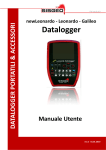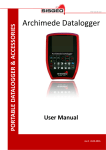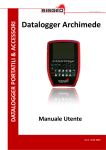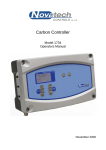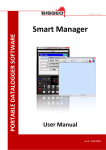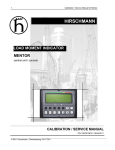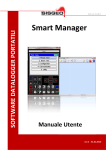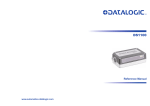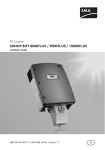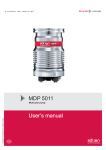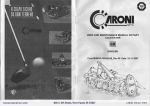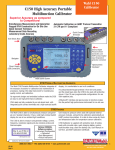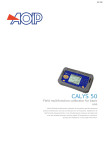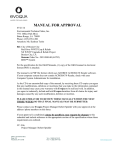Download Portable Dataloggers User Manual rev.2_EN
Transcript
PORTABLE DATALOGGER &ACCESSORIES FW ver.0.4.0 new Leonardo – Leonardo – Galileo Datalogger User Manual rev.2 -31.01.2013- Portable Dataloggers User Manual INDEX NOTE ON SYSTEM UTILIZATION Pag.4 WASTE DISPOSAL Pag.5 SYMBOLOGY Pag.5 IDENTIFICATION PLATE Pag.6 DL OVERVIEW Pag.7 INTRODUCTION Pag.7 LEONARDO (0CDL200UN00) Pag.8 new LEONARDO (0CDL400N000) Pag9 GALILEO (0CDL100VW00) Pag.10 ARCHIMEDE (0CDL300INCL) Pag.11 ACCESSORIES and SPARE PARTS Pag.12 DL STORAGE AND TRANSPORT Pag.12 BATTERIES Pag.13 Battery charger Pag.13 Internal temperature Pag.14 How to use the battery charger Pag.14 Charge cycle and LED indication Pag.15 USER INTERFACE Pag.16 Edit boxes Pag.20 Buttons Pag.21 Lists Pag.21 Radio buttons Pag.22 Tuning backlight Pag.22 On line help Pag.22 THE MAIN MANU Pag.23 CONFIGURING SITES Pag.24 CONFIGURING INSTRUMENTS (SINGLE) Pag.26 CONFIGURING MULTIPLEXER (STANDARD), CHAIN OF DIGITAL INCLINOMETER SWITCH PANEL and WORKLISTS Pag.36 EDITING A MULTIPLEXER CHANNELS (STANDARD) Pag.39 EDITING SISGEO’S DIGITAL INCLINOMETER’S CHAIN PARAMETERS Pag.41 EDITING SWITCH PANELS CHANNELS Pag.42 EDITING WORKLISTS ITEMS Pag.44 READING INSTRUMENTS (SINGLE) Pag.46 READING DIGITAL’S INSTRUMETS (SINGLE) Pag.50 BROWSING INSTRUMENT READINGS Pag.52 Rev.2 -31.01.2013- 2|Page Portable Dataloggers User Manual READING STANDARD INSTRUMENTS (SINGLE) Pag.53 READING MULTIPLEXERS, SWITCH PANEL and WORKLISTS Pag.54 READING MULTIPLEXER (STANDARD) Pag.55 READING SISGEO’S DIGITALINCLINOMETERS CHAINS Pag.57 READING SWITCH PANNELS Pag.58 READING WORKLISTS Pag.59 USING THE USB INTERFACE Pag.61 USE WITH SMART EXPORT and SMART MANAGER Pag.61 USE WITH SMART DATACAL Pag.62 USE WITH SMART REMOTE Pag.62 USING THE BLUETOOTH INTERFACE Pag.64 Android 2.2 Froyo™ Pag.66 rd Symbian S60 3 Edition™ Pag.66 RIM™ ver.5.0.0.822 Pag.66 Windows Mobile™ ver.5 & 6 Pag.67 UTILITIES Pag.68 SETTING DATE and TIME Pag.68 CHECKING DL STATUS Pag.69 CHECKING USER INTERFACE LANGUAGE Pag.69 TROUBLE SHOOTING Pag.71 ASSISTANCE Pag.72 Repairs and maintenances Pag.72 Phone assistance Pag.72 Technical assistance on site for the supplied instrumentations Pag.72 Training Pag.72 APPENDIX –A- Pag.73 Standard\Digital mono instruments Pag.73 Vibrating wire instruments Pag.75 Bi-Axial instruments Pag.75 Probes\Digital probes Pag.76 SPECIAL KEYBOARD COMBINATIONS Pag.77 Switch ON Pag.77 Switch OFF Pag.77 Alternate display modes Pag.77 Emergency reset Pag.77 Firmware upgrade Pag.78 EARLIER FIRMWARE VERSION Pag.78 TECHNICAL DATASHEET Pag.79 Rev.2 -31.01.2013- 3|Page Portable Dataloggers User Manual NOTE ON SYSTEM UTILIZATION To ensure a safe and efficient functioning, please read the following instructions carefully before use. Any unauthorized modification is considered a total responsibility of the user. In addition to the standards listed above, the user must comply with the existing legislation on safety and health of employees in the workplace. Check the product for damages caused by transport. Verify that your package includes all standard accessories and any accessories required. In case, contact SISGEO and/or the distributor. The use of the portable datalogger shall be done only after the proper connection and following the configuration needed; so the user must carefully perform all the operations described herein. SISGEO will not be liable for inconveniences, damages, accidents, etc.. due to lack of knowledge (or non-application) of the requirements contained in this manual. The use, any possible maintenance or repair of the equipment is allowed only to skilled and authorized operators. These operators must be physically, professionally and intellectually capable. For information or orders of spare parts always specify the serial number reported on the identification plate showing on the back of device. When replacing parts, use only ORIGINAL SPARE PARTS. The use of unoriginal SISGEO spare parts may cause irregular functioning and dangers for people and objects The product is not fit for installation in small and/or unventilated environments, with a high humidity range or in presence of inflammable or explosive liquids. All the instruments and the equipment furnished are not suitable for installation in potential dangerous area or when the use of explosion-proof components is foreseen. The electrical connections must be executed by a qualified installer, observing the effective regulations. The manufacturer reserves the right to make changes, in case of any manufacturing or commercial need, without notice. It will attempt to ensure that user manuals are updated in order to reflect functional product revisions. Rev.2 -31.01.2013- 4|Page Portable Dataloggers User Manual WASTE DISPOSAL According to the European standard 2002/96/CE, the disused instrument must be disposed in a correct way. The recyclable materials are recovered, in order to avoid the environmental damage. For more information please contact your waste disposal service or the instrument retailer. SYMBOLOGY Here are the symbols used in this manual to alert the reader: Attention! This operation must be executed only by specialized personnel. Pay particular attention to the following information. Rev.2 -31.01.2013- 5|Page Portable Dataloggers User Manual IDENTIFICATION PLATE Each portable datalogger have two types of identification plates. One of these shows the product registration Serial Number and is on the back of DL. It is important to communicate this data when requesting information concerning the product. The second plate is always located on the back of the DL. Follow the requirements on the plates. Failure to comply with these requirements could result in damage to the device and danger to the operator. Rev.2 -31.01.2013- 6|Page Portable Dataloggers User Manual DL OVERVIEW Display TFT DL model Keyboard Mini USB Connector for PC connection/ record key Jack Plug for battery charger MIL Connector for instrument connection INTRODUCTION Depending on the type of your portable datalogger (DL), it is possible read different instrument types. Analog Digital Probe Vibrating wire Leonardo New Leonardo Galileo Archimede For further details please see “Appendix A”. Rev.2 -31.01.2013- 7|Page Portable Dataloggers User Manual LEONARDO (0CDL200UN00) The Leonardo DL has been developed to make and store readings obtained from different analog and digital instruments (except for vibrating wire instruments); Leonardo DL can’t perform inclinometer tests. The Leonardo DL is mainly composed by: • Shoulder and shipment bag (0CDL0BAG927) • Battery charger for NiMH batteries (0ECAB12VNMB) • Flying cable: 1 MIL connector and 6 alligator clips + ground (0ECAV7P6A00) • IP68 USB cable for PC connection • CD ROM (Manuals, Smart Manager Suite) Shipment bag Shoulder bag Flying cable USB cable Atte Rev.2 -31.01.2013- 8|Page Portable Dataloggers User Manual new LEONARDO (0CDL400N000) The new Leonardo DL has been developed to make and store readings obtained from various instruments, including analog, digital and vibrating wire instruments: The New Leonardo DL is mainly composed by: • Shoulder and shipment bag (0CDL0BAG927) • Battery charger for NiMH batteries (0ECAB12VNMB) • Flying cable: 1 MIL connector and 6 alligator clips + ground (0ECAV7P6A00) • IP68 USB cable for PC connection • CD ROM (Manuals, Smart Manager Suite) Shipment bag Shoulder bag Flying cable USB cable Caricabatteria Rev.2 -31.01.2013- 9|Page Portable Dataloggers User Manual GALILEO (0CDL100VW00) The Galileo DL has been developed to make and store readings obtained from vibrating wire instruments (and its thermistor NTC). The Galileo DL is mainly composed by: • Shoulder and shipment bag (0CDL0BAG927) • Battery charger for NiMH batteries (0ECAB12VNMB) • Flying cable: 1 MIL connector and 4 alligator clips + ground (0ECAV7P4A00) • IP68 USB cable for PC connection • CD ROM (Manuals, Smart Manager Suite) Shipment bag Shoulder bag Flying cable USB cable Battery charger Rev.2 -31.01.2013- 10 | P a g e Portable Dataloggers User Manual ARCHIMEDE (0CDL300INCL) The Archimede DL has been developed to make and store readings obtained from inclinometer test (both analog and digital inclinometers). The Archimede DL is mainly composed by: • Shoulder and shipment bag (0CDL0BAG927) • Battery charger for NiMH batteries (0ECAB12VNMB) • IP68 external button for data storage - Archimede DL (0CDL300REMC) • Flying cable: 2 MIL connectors M/F 7 pins (0ECAV07V200) • IP68 USB cable for PC connection • CD ROM (Manuals, Smart Manager Suite) Shipment bag Shoulder bag Battery charger Rev.2 -31.01.2013- Flying cable USB cable IP68 external button 11 | P a g e Portable Dataloggers User Manual ACCESSORIES AND SPARE PARTS Flying cables: • 1 MIL connector and 2 alligator clips + ground (0ECAV7P2A00) • 1 MIL connector and 4 alligator clips + ground (0ECAV7P4A00) • 1 MIL connector and 6 alligator clips + ground (0ECAV7P6A00) • 2 MIL connectors M/F 7 pins (0ECAV07V200) • IP68 external button for data storage - Archimede DL only (0CDL300REMC) • Multiplexer measurement (0ECAV10MUX0) External 12V battery pack (0CDL012EXBP) Internal Bluetooth module (0CDL0BTOOTH) : this module shall be requested together with DL purchase order; can be added later only by SISGEO. Shoulder and shipment bag (0CDL0BAG927) Battery charger for NiMH batteries (0ECAB12VNMB) External 12V battery pack Multiplexer measurement cable DL STORAGE AND TRANSPORT To store correctly the DL, it is advised to use the supplied bag. Put carefully the DL in the suitable compartment with the display turned inside. During the transport it is advised to use the shoulder bag and to avoid bumps. Rev.2 -31.01.2013- 12 | P a g e Portable Dataloggers User Manual BATTERIES Each DL is powered by an internal rechargeable NiMh battery. If properly used, the NiMH batteries are rated for at least 500 discharge cycles. An effect known as the "memory effect", which will degrade the readout's performance during use, may occur if the batteries are left under charge for some days or if they are repeatedly/ partially discharged. In order to prevent this, it is recommended to use exclusively the battery charger supplied with the DL and to cycle (charge and fully discharge) the batteries at least once every two/three weeks. The batteries should be charged only when they are completely discharged and not before: charge it before only when you have to use the DL. Furthermore, if the DL is not going to be used for an extended period it is preferred to store the DL with the batteries fully charged. Well charged batteries provide at least 8 hours of continuous use: this means that the batteries provide charge for more than a day's work. If the DL is not used for months, the batteries lose their capacity due to the auto-discharge. The first time a battery charger is connected, this could signal green also if the batteries are not fully charged: it is advised to repeat the charge cycle twice. Using a good battery, a full battery charge allows a non-stop use of at least 8 hours: this means that with a full charge it is possible to work on site for more than a day. BATTERY CHARGER The battery charger supplied is a microprocessor controlled with rapid charge in less than 3 hours. The input voltage range is universal (90-264 V ). This battery charger uses a method called “–dv detection”; this method is based on the fact that the voltage drops over the NiMH cells when the batteries are fully charged: this voltage drop is detected when the voltage has dropped a certain percentage from the highest value and the charge will be automatically completed. If this voltage drop does not occur, the battery charger has a safety timer which will terminate charging after a given period of time to avoid batteries overcharging. For battery cells which have been idle for a long period of time, the voltage could drop in the first part of the charge cycle. For this reason, a start-timer is built into the battery charger to prevent ” –dv detection” in the first minutes of the charge cycle. Don’t take instrument readings with battery charger connected to the DL. Rev.2 -31.01.2013- 13 | P a g e Portable Dataloggers User Manual Don’t use a different type of battery charger. It is necessary use only the furnished battery charger (0ECAB12VNMB) INTERNAL TEMPERATURE If, for any reason, the internal temperature in the DL is more than 70°C there is a safety system that disconnects the battery until the temperature decrease under 70°C. So, if after the battery charge the DL won’t switch on, wait for the battery cooling until it returns within an adequate temperature range. HOW TO USE THE BATTERY CHARGER The battery charger is started by connecting the jack to the readout and then connecting the battery charger at the voltage line. NOTE: To avoid damages, always insert the battery charger jack in the DL before connecting the battery charger at power supply network, likewise, before disconnecting the battery charger jack from the readout disconnect the battery charger from the power supply network. The LED on the battery charger will be yellow before the fast charge starts and then the LED changes to orange. When the batteries are fully charged the LED will be green. Do not leave the battery charger connected to the DL for more than 24 hours. If the battery voltage is less than the normal one the LED will then indicate "error" by flickering green and orange light. Rev.2 -31.01.2013- 14 | P a g e Portable Dataloggers User Manual CHARGE CYCLE AND LED INDICATIONS LED Yellow Yellow Orange Green with intermittent yellow flash Green Alternating orange – green MODE Battery not connected Battery initialisation and analysis Fast charge Top-off charge Trickle charge Error Connecting the battery charger at the voltage, the LED will become orange for the first 5-7 seconds, then it turns to yellow when the initialisation and the analysis starts. If the battery is connected, the actual charging will start a few seconds later when the LED changes to orange. When the battery is charged the LED will be green in approx. 4 seconds. This is only a signal to test the service. When –dv has been detected, the start of the top-off charge is indicated with a green LED with intermittent yellow flashes. The LED will be green during trickle charge. Rev.2 -31.01.2013- 15 | P a g e Portable Dataloggers User Manual USER INTERFACE To switch the DL on, press the ON/OFF key while keeping the INFO key pressed. After a few seconds the DL will switch on and the display will show a start-up page. This page will display the type of DL and the version of the firmware. At the bottom of the display the name of the DL will show up: this is an user assigned name that can be used to distinguish between different DLs. Keeping the name of different DLs distinct is important when importing data to a PC, so that the source of the data can be traced. DL type Battery Status Firmware version Unit Name At the upper right corner the display shows the current status of the battery: the remaining charge is shown by the number of bars. Press ENTER or wait a few seconds to display the Main menu. Rev.2 -31.01.2013- 16 | P a g e Portable Dataloggers User Manual When the battery voltage drops below about 12.5 Volts, the bars will turn red. At about 10.5V the DL will stop all activities, then it will beep and switch off. To limit battery consumption, after three minutes without user activity, the display will switch off, after ten minutes the DL will switch off. To switch the DL off press the ON/OFF key while keeping the ENTER key pressed; the DL will display a window on top of the current page with a bar at the bottom. When the bar is completely filled, the DL will ask to release all keys and then it will switch off. Other keys combinations are described in the Special keyboard combinations chapter. Rev.2 -31.01.2013- 17 | P a g e Portable Dataloggers User Manual The user interface is made of a series of screens containing control items similar to those available in Windows. Screens contain different items such as lists, buttons, edit boxes and check or radio buttons. Only one of the controls on the screen has focus: the currently focused control is highlighted in blue and normally indicates the action performed by pressing the ENTER key. Active control If the selected control is an edit control, characters typed on the keyboard will edit its content. Text control Rev.2 -31.01.2013- 18 | P a g e Portable Dataloggers User Manual You may change the selected control by clicking the PREVIOUS (scroll) and NEXT (scroll) keys on the left side of the keyboard. As all keys, they have an auto-repeat behavior when held pressed. All controls in a page are in circular list so that clicking NEXT (scroll) when the last control is selected moves the selection to the first control of the screen. Similarly clicking PREVIOUS (scroll) on the first control moves focus to the last control. Rev.2 -31.01.2013- 19 | P a g e Portable Dataloggers User Manual EDIT BOXES An edit box is used to display and edit text; when text to be entered is a number, either an integer or a number with decimals, the numeric keys and the decimal point are used to directly type the digits and decimals separator. The +/- key is used to enter a + or – sign, instead the “e” for the exponent part. Just press the +/- key: the DL will show a list of characters. Press the +/- key repeatedly till the character you wish to insert is selected, then wait till the list of characters disappears and the selected character will be inserted in the edit box. When you need to enter text, all the numeric keys and the +/- and the . keys behave in this way: press any of these keys repeatedly to enter the desired character. Press the DEL key to delete the character on the left of the cursor. If you keep the DEL key pressed for about a second, the content of the edit box is deleted (quick delete). The characters available for each key are: Rev.2 -31.01.2013- +/- -+()%# . .,:; 1 1$°εµα/\ 2 AB C 2 a b c 3 DEF3def 4 GHI4ghi 5 JKL5jk l 6 MNO6mno 7 PQ R S 7 p q rs 8 TUV8tuv 9 WXYZ9wxyz 0 0 ̺ (space) ! ? 20 | P a g e Portable Dataloggers User Manual BUTTONS Buttons are used to select an action, which frequently means navigating to a new screen. Just move focus to the desired button and click the ENTER key. As an alternative, most buttons contain a number at the left of their labels; just click the matching number to trigger the button action. Generally no BACK or ABORT button is on the screen, to return to the previous screen or abort the current operation just press the ESC key on the keyboard. When no button is selected, the ENTER key is normally used to confirm the most obvious operation: for example when a list is selected, clicking the ENTER key will usually bring you to the next screen with the currently selected item. LISTS Lists are used to select one of several items; when a list is selected, you may change the selection clicking the UP or DOWN keys. The LEFT key will move to the beginning of the list and the RIGHT key will move to the end. By clicking ENTER, the current item is selected. Only in configuration windows, when a list box is displaying items defined by the user (for example sites or instruments) it is usually possible to delete the selected item pressing the DEL key, when the desired item is selected and when you are in configuration menus. The DL will require a confirmation to avoid accidental deleting; it doesn’t happen if the item has no data inside. Rev.2 -31.01.2013- 21 | P a g e Portable Dataloggers User Manual RADIO BUTTONS Radio buttons are used to select one of a few possible options. To select an item move the selection to it clicking NEXT (scroll) or PREVIOUS (scroll) and press ENTER key. TUNING BACKLIGHT Backlight may be switched on and off by pressing the LIGHT key. You may tune backlight level to adapt to field conditions. Keep the LIGHT key pressed and press the PREVIOUS (scroll) key to increase light or the NEXT (scroll) key to decrease it. ONLINE HELP In order to display online help, press the INFO key. actually no help on line is implemented Rev.2 -31.01.2013- 22 | P a g e Portable Dataloggers User Manual THE MAIN MENU The main menu gives access to all the functions of the DL. Manual read In this section you may configure, read instruments and store readings. Available instruments include: • Standard: analog and digital mono-axial/mono-channel instruments; • Biaxial: analog and digital bi-axial/bi-channel instruments; • VW: Vibrating Wire instruments (with relative NTC thermistor) Some instruments may not be available due to the DL type being used (See “INTRODUCTION”). Batch read In this section you may read: • Multiplexers: SISGEO Multiplexer Box and digital SISGEO inclinometer chains • Switch Panels: SISGEO Switch Pannel • Work lists; they are not physical devices: they are just a list of instruments to read, possibly in different location. They are designed to support the user in keeping track of different instruments to read. Configuration In this section you may configure Instruments, Multiplexers, Switch Panels and Work lists. Communication In this section you may connect to a PC using the USB port; some DLs support a Bluetooth module which is also managed in this section Utility In this section you may set date and time, select the language for the user interface and run a checkup for the DL. Rev.2 -31.01.2013- 23 | P a g e Portable Dataloggers User Manual CONFIGURING SITES DLs have a permanent memory used to store configuration data (such as Instruments and Multiplexers), as well as acquired data (as Readings). Also if the memory’s maximum capacity is remarkable (2GB), DL export and synchronization speed with the PC depends on the inner data quantity. We advise not to charge exceedingly DL’s memory and to use it only to save the DL’s files. All data in a DL is divided in sites: how to define sites is up to the user, but it is expected them to be named after the physical sites where readings are performed. To view the site’s list , select Configuration in the main menu, then select Sites. The list of sites is initially empty. To add a new site, make sure that the edit box at the bottom of the screen is active (you should see a blinking cursor in it) and type the name for the new site, then press ENTER. The new site will be shown in the list on the page. Rev.2 -31.01.2013- 24 | P a g e Portable Dataloggers User Manual The name of the site, as well as the name of a Multiplexer, Switch Panel, Worklist or Inclinometer Tube, should be composed of the same characters used for Microsoft Windows valid file names, so, all characters except the following: < > : " / \ | ? *. To delete a site, select it in the sites list and make sure that the site list has focus, then press the DEL key; if the site is not empty, the DL will ask to confirm the operation. Rev.2 -31.01.2013- 25 | P a g e Portable Dataloggers User Manual CONFIGURING INSTRUMENTS (SINGLE) Every instrument (analog, digital and vibrating wire) must be configured in the site to which they belong. SISGEO’s digital instruments can be configured only in reduced form since every configuration parameter (serial number, calibration coefficient etc..) are already included in the instrument. To browse or edit instruments defined in a site, select Configuration in the Main menu, then select Instruments. The DL will display a list of sites, select the site you are interested in and press ENTER key. The display will show a list of instruments configured for the given site. The list of instruments is initially empty, later on you will be able to edit any of the instruments defined in it by selecting it and pressing ENTER key. To define a new instrument, click the New button. Rev.2 -31.01.2013- 26 | P a g e Portable Dataloggers User Manual The categories of instruments are listed at the top of the screen; select the category for your instrument and press ENTER key. The selection will pass to the list of instrument types of the given category; select the instrument type according to your instrument and press ENTER key (Instrument’s type for each kind are listed in Appendix A). The display will show configuration data for your instrument. Rev.2 -31.01.2013- 27 | P a g e Portable Dataloggers User Manual These data include: Name: Notes: Code: Unit: Warm-up: Decimals: The name used to identify the instrument: this is initially set the same as the instrument code, but should be changed from the user before saving the instrument. User notes related to the instrument. The instrument model: this field cannot be edited by the user. The unit of measure (label): the user may either select it from the drop down list or edit a new unit of measure.(editable only for analog instruments) The warm-up time recommended for the instrument in seconds: this is used by the DL when reading instruments connected through a Multiplexer (editable only for analog instruments). The number of digits after the decimal separator used when displaying readings; for example 3 means that the number will be formatted as 20.000. After editing data in this screen, press ENTER key, the DL will display the cabling screen (instrument’s wire colors). Secondary color list Prime color list Rev.2 -31.01.2013- 28 | P a g e Portable Dataloggers User Manual The colors for each wire are preset for the instrument category you have selected, but it is possible to edit them. Use the UP and DOWN keys to select the wire you need to edit (e.g. G: Shield). Then press the NEXT (scroll) key to move to the list for the primary color on the right and use the UP and DOWN keys there to select the wire color. Then click the PREVIOUS (scroll) key to get to the wires list on the left. Rev.2 -31.01.2013- 29 | P a g e Portable Dataloggers User Manual If the wire has two colors: • Select the wire in the first list, • Press the NEXT (scroll) key to get to the primary color list in the middle, • Select the primary color by UP or DOWN keys • Press the NEXT (scroll) key to get to the secondary color list on the right • Select the secondary color by UP or DOWN keys • Press the PREVIOUS (scroll) key twice to get to the wires list on the left. To delete the colors for a cable: • Select the wire in the first list, • Press the NEXT (scroll) key to get to the primary color list in the middle, • Press the DEL key. To delete just the secondary color: • Select the wire in the first list, • Press the NEXT (scroll) key to get to the primary color list in the middle, • Press the NEXT (scroll) key to get to the secondary color list on the right • Press the DEL key. • Press the PREVIOUS (scroll) key to get to the wires list. When you have edited the cable color, press the ENTER key to get to the calibration page. Rev.2 -31.01.2013- 30 | P a g e Portable Dataloggers User Manual For SISGEO’s digital instruments is only possible to configure Name, Note and Decimal: It is not possible to configure the color scheme for this kind of instrument. The calibration page for instruments depends on the instrument type SISGEO’s digital instruments calibration is already included in each instrument, so it is needed no calibration. For the other instruments it is possible to enter a calibration polynomial (with a degree of 1 to 3) that is used to convert from the electrical measure (e.g. mA or mV) to the physical unit measured by the instrument (e.g. kPa). Initially the list of polynomials (degrees) is listed at the top of the screen. Select the polynomial you wish to use with the UP and DOWN keys: it is possible to select one of the following families of polynomials: • • • Ax+B A x2 + B x + C A x3 + B x2 + C x + D Then click the NEXT button to edit the coefficients for the polynomial according to SISGEO’s Calibration Report. Rev.2 -31.01.2013- 31 | P a g e Portable Dataloggers User Manual A B C D When you have finished entering parameters, click the Save button: the newly created instrument will be displayed in the instruments list for the site. After you have created some instruments, you may make a copy of an existing instrument by clicking the Duplicate button. The DL will create a new instrument which is an exact copy of the selected instrument. You must change at least the name of the new instrument before saving, because two instruments with the same name cannot coexist in one site. Rev.2 -31.01.2013- 32 | P a g e Portable Dataloggers User Manual If you fail to give a new name for the instrument, or in any case when using an existing name for a new instrument, you will get a warning message. When entering the calibration for a dual instrument, you will be asked to enter the coefficient for two polynomials to be used for the linearization of the first and the second channel. The calibration requires different sets of parameters for platinum thermo-resistance PT100 instruments (P111PT10). Rev.2 -31.01.2013- 33 | P a g e Portable Dataloggers User Manual Calibration values for PT100 instruments should not be changed by user. The calibration requires different sets of parameters for NTC thermistor (T3100GKA): Calibration values for NTC thermistor should not be changed by user. For vibrating wire instruments two pages of parameters must be entered. The first page refers to the linearization polynomial (polynomial coefficients have the same meaning they have in mono instruments. The second page contains the gauge parameter for the wire and the coefficients for the thermistor. Rev.2 -31.01.2013- 34 | P a g e Portable Dataloggers User Manual If the “gauge” parameter is blank, the user unit is calculated from digit’s value (using the polynomial defined from the user); In this case will be displayed the digit reading If the “gauge”parameter is edited editato, the user uniti s calculated from the µƐ (using the polynomial defined from the user) In this case will be displayed the µƐ reading Only readings in configured unit (first page) can be stored in DL memory. Calibration values for the thermistor used with the wire should not be changed by user. If the gauge value inserted is zero, the screen with the unit of measure in µƐ will be displayed anyway, but the reading will result zero. While editing the instruments parameters you can return to the previous page pressing the ESC key. If you press ESC key on the first page you will return to the instruments list without saving your changes. For vibrating wires instruments different values can be displayed during the measure: • • • Hz (Hertz) the measured frequency of the oscillation μs (micro seconds) the period of the oscillation με o μEpsilon (micro Epsilon) calculated as: μEpsilon gauge digit • Digit calculated as: Digit • 1000 User units are calculated using the polynomial entered by the user. Rev.2 -31.01.2013- 35 | P a g e Portable Dataloggers User Manual CONFIGURING MULTIPLEXER (STANDARD),CHAINS OF DIGITAL INCLINOMETER, SWITCH PANEL and WORKLISTS Before configuring Multiplexers, Switch Panels and Work lists (from now we call these items Selectors, when the differences are not relevant), you must define the instruments that you wish to read through these Selectors in the same site in which you wish to add a new Selector. The single SISGEO’S digital inclinometers from a digital inclinometer’s chain must NOT be configured. Refer to the Configuring Instruments chapter for details about configuring instruments. To configure any of these Selectors (considering Work lists as a sort of virtual device), select Configuration and then click the appropriate button for the type of Selector you wish to configure. The process is very similar for all of them, except that different data is used to identify the position on the Selector of a given instrument. First the DL will display a screen to select the site in which the Selector should be added, then a list of the Selectors of the chosen type already defined in the site will be displayed: When one or more Selectors are listed it is possible to delete one of them by selecting it in the list and pressing the DEL key: the DL will ask the user to confirm this operation. Rev.2 -31.01.2013- 36 | P a g e Portable Dataloggers User Manual It is also possible to make a copy of an existing Selector by selecting it in the list and clicking the Duplicate button: the DL will ask the name for the new Selector. Every list is initially empty, so that the only chance is to press the key Create. All lists are initially empty, so that the only possibility is to click the New button. The DL will display a screen asking the name for the new Switch Panel or Worklist. Enter the name for the new Switch Panel or Worklist and press ENTER. In the case of Multiplexers it will also ask some information about the kind of Multiplexer that will be used: the number of channels and the number of wires per channel. Number of physical channels of the Multiplexer board Configuration type of the Multiplexer board (es. 4-20mA current loop: 2 wires, PT100 platinum RTD: 4 wires) Once inserted Multiplexer’s name, move on the flag button that match the type of the Multiplexer using the keys NEXT (Scroll) or PREVIOUS (Scroll) and push ENTER. Please be careful, especially when choosing between 2 and 4 wires models, as the multiplexing sequences are not compatible and the DL will be unable to perform any valid reading on an incorrectly configured Multiplexer. Rev.2 -31.01.2013- 37 | P a g e Portable Dataloggers User Manual In case of doubts you can verify the DIP switch panel position on the multiplexer Board: only the switch 1 and 2 are relevant ( the position of the dip-switch from 3 to 8 can change). 2 wires Multiplexer MUX16 – 2 wires 4 wires Multiplexer MUX16 – 4 wires MUX32 – 2 wires MUX32 – 4 wires Choose “digital Inclinometers” when you want to read SISGEO’s digital Inclinometer’s chains. Pay attention to the difference between Multiplexer (Standard) and digital Inclinometers: the DL settings are totally different. Refer to the chapter “EDIT SISGEO’S DIGITAL INCLINOMETER CHAIN PARAMETERS” for details. Rev.2 -31.01.2013- 38 | P a g e Portable Dataloggers User Manual EDITING A MULTIPLEXER CHANNELS (STANDARD) After the creation of a new multiplexer press ENTER after having selected a Multiplexer in the list of Multiplexers for the current site; the display will show the channel assignment for the current Multiplexer. The first few channels are visible and the first channel is selected. Press the DOWN key to change the selected channel and to scroll the list. The number of channels in the Multiplexer (as well as their type) was set when the Multiplexer was initially created and cannot be changed now: there is consequently no way to add or remove channels; you may just assign an instrument to a channel or clear such an assignment. To select an instrument for the current channel, press ENTER: the display will show a list of all the instruments defined in the current site. Select an instrument and press ENTER again; the display will show the current position in the Multiplexer for the selected instrument. Rev.2 -31.01.2013- 39 | P a g e Portable Dataloggers User Manual It is possible to edit a notes field. When finished press ENTER: the instrument will be added in the selected position of the Multiplexer. To remove an instrument from a multiplexer, just select it and press the DEL key. A confirmation window will appear. Some instruments need to use two consecutive channels on a Multiplexer. When such an instrument is selected, the fact that an additional channel is used is marked by a quote character. When you have finished, press the ESC key. Rev.2 -31.01.2013- 40 | P a g e Portable Dataloggers User Manual EDIT SISGEO’S DIGITAL INCLINOMETER’S CHAIN PARAMETERS EDITARE I PARAMETRI DI UNA CATENA DI INCLINOMETRI DIGITALI SISGEO After the creation of a new SISGEO’s inclinometer chain, press ENTER after having selected a chain in the list of the current site multiplexer, the display will show the settings used to read the chain. The parameters set here are used from the DL to read the digital inclinometers, so they have to match exactly to the ones in the inclinometer’s chain: changing the parameters in this screen, will not change the parameters set in the inclinometer’s chain. Please refer to the documents supplied from SISGEO to retrieve the settings of the digital inclinometers. Typically the chain’s instrument are identified consequentially starting from number one to the instrument’s total number: this last number has to be inserted in the field Addr. max. (Address RS485 maximum). To reduce the DL’s current consumption, inclinometer’s chains can be configured in order to switch on the inclinometers in different times; this function is managed through two parameters: warmup and delay. If the inclinometer chain has been enabled the energy saving, check the option “Energy Saving” and fill in the field warm-up and delay according to the inclinometer’s chain parameters. After editing address 485 max in the inclinometer’s chains, to check the option “Energy saving” just press the key Next (scroll) and then press the key “.”: will be automatically enabled the fields “Warm up”(s) and “Delay”(s). When the option “energy saving” is enabled, every inclinometer from the chain will switch on after a different delay, according to its address; during the reading the datalogger will wait the suitable time before to read an instrument and move to the next one. Every inclinometer will turn off after the reading. Waiting time = (RS485 address * delay) + warm up When the option “energy saving” is NOT enabled every inclinometer of the chain will be powered and switched on at the same time. The inclinometers will switch off after the reading. Rev.2 -31.01.2013- 41 | P a g e Portable Dataloggers User Manual The maximum number of digital inclinometers that can be read from the DL at the same time (option energy saving not enabled) is 20: stick to this number to avoid damages to the DL and/or to the digital inclinometers. The (theoretical) maximum number of digital inclinometers that can be read from the DL sequentially (option energy saving enabled) is 254 (addresses RS485 from 1 to 254). EDITING SWITCH PANELS CHANNELS After creating a new Switch Panel press ENTER after selecting a Switch Panel in the list of Switch Panels for the current site; the display will show the channel assignment for the current Switch Panel. When first created, switch panels are empty; click the Add button to add an instrument: the DL will display a page for selecting the instrument to add. Select instrument and press ENTER: the DL will display a page for selecting the Selector and the Position on the Selector for the new instrument. Rev.2 -31.01.2013- 42 | P a g e Portable Dataloggers User Manual Enter Selector and Position and eventually fill the Notes field, then press ENTER. The instrument will be added to the Switch Panel. To delete an instrument from the Switch Panel, just select it and press DEL key. A confirmation window will appear. When you have finished, press the ESC key. Rev.2 -31.01.2013- 43 | P a g e Portable Dataloggers User Manual EDITING WORKLISTS ITEMS After creating a new Worklist press ENTER after selecting a Worklist in the list of Work lists for the current site: the display will show the channel assignment for the current Worklist. When first created, Work lists are empty; click the Add button to add an instrument: the DL will display a page for selecting the instrument to add. Select instrument and press ENTER. The DL will display a page in which you may edit a Position and a Notes field. Rev.2 -31.01.2013- 44 | P a g e Portable Dataloggers User Manual Write in the Position field something that will help you to locate the instrument when later you will be performing measures. Press ENTER to add the new item in the Worklist. To delete an instrument from the Worklist, just select it and click DEL key. A confirmation window will appear. When you have finished, press the ESC key. Rev.2 -31.01.2013- 45 | P a g e Portable Dataloggers User Manual READING INSTRUMENTS (SINGLE) To read single instruments, select Manual read from the Main menu. The DL will display a list of sites; you may either select a site and press the ENTER key or click the Standard button at the bottom of the display. If you click Standard you will be able to select a predefined instrument (not configured from the user): refer to Reading standard instruments for details. When selecting a site, you will see a list of the instruments, previously configured from the user, defined in the current site. Select and instrument and press ENTER to proceed reading it, by clicking Browse instead, you will be able to view an history of measures performed on the instrument in the past. Rev.2 -31.01.2013- 46 | P a g e Portable Dataloggers User Manual The DL will display a description of the connection cables for the selected instruments. Connect the flying cable (1MIL connector and alligator clips) to the DL. Never force a connector into the port. Check for possible obstructions in the port. If the connector and port do not connect easily, they probably do not match. Make sure the connector matches the port. Connect the instrument cables to the alligator clips. To avoid damage to the DL or to the instrument take care to not make shortcircuit with clips of the flying cable. Check that the cable is connected correctly and that the instrument type is compatible with the one selected on the DL (description in the upper part of the screen): an erroneous connection may damage the DL or the instrument. Press the ENTER key to start measuring the instrument. Rev.2 -31.01.2013- 47 | P a g e Portable Dataloggers User Manual If you press ENTER while the reading is being displayed, the current value will be recorded in the history file; a beep will confirm recording. The history file may be browsed for readings of a selected instrument by clicking the Browse button in the Instrument selection window. Please note that it is not possible to record readings performed with standard instruments (not configured from the user). Press ESC key when you are finished reading the instrument. If the DL detects a problem with the instrument, it will display a dialog. You should fix the problem and click OK or click Cancel to terminate the operation. When the instrument being read is a vibrating wire instrument, pressing the RIGHT and LEFT key you may cycle through the following measures: • • • • • μEpsilon Physical unit, μs, Hz, Digits Rev.2 -31.01.2013- 48 | P a g e Portable Dataloggers User Manual “kPa” if configured by the user “Digit” if not configured (default) The με value will be shown only if it had been inserted gauge value during instrument’s definition. If you insert a gauge value =0, a screen with με will be displayed, but the values will remain 0 Note that these are just the results of different computations on a single physical measure, namely the frequency of the vibrating wire. Rev.2 -31.01.2013- 49 | P a g e Portable Dataloggers User Manual READING DIGITAL’S INSTRUMENTS (SINGLE) The procedure for reading SISGEO’S single digital instruments configured from the user, is equivalent of single analog instruments (see paragraph “READING (SINGLE) INSTRUMENTS. To read SISGEO’S digital inclinometer chains see paragraph “READING SISGEO’S DIGITAL INCLINOMETER CHAINS The only precaution is to be certain that the digital instrument to be read DOES NOT have the function energy saving enabled; otherwise will be displayed the message “The instrument is not connected”. The reading shows is already in physical unit (see “APPENDIX A” for further details) During the reading of a digital instrument, pressing the RIGHT key, it is possible to display the temperature read from the probe. Rev.2 -31.01.2013- 50 | P a g e Portable Dataloggers User Manual Attention: this function is possible only if it used a digital instrument. If the DL discover an incompatibility with the digital instrument (for ex. Is selected a digital monoaxial inclinometer while the connected inclinometer is bi-axial) will be shown a dialog box: If the DL can’t read the digital instrument connected will be shown the following dialog box: In this case verify the connections and that the instrument has the energy saving function is disabled. Rev.2 -31.01.2013- 51 | P a g e Portable Dataloggers User Manual BROWSING INSTRUMENT READINGS To browse readings recorded with an instruments select Manual read from the Main menu and select the instrument site as you would do for reading an instrument. Now select the instrument whose readings you wish to browse and click the Reading button. Note that it is not possible to browse readings performed with Standard Instruments, as such readings are not recorded. The DL will display a list of readings. You may delete the currently selected reading by pressing the DEL key. Deleted readings will not disappear immediately, they will just be hilighted in red; you may undelete a reading by pressing the DEL key again. After exiting this window, readings marked for deletion will actually be purged. When you have finished, press the ESC key. Rev.2 -31.01.2013- 52 | P a g e Portable Dataloggers User Manual READING STANDARD INSTRUMENTS (SINGLE) It is possible to read instruments without configuring them, by using Standard Instruments; in this case instruments are read without using any calibration parameters, so such readings may be used to test that a given instrument is functional or to read the instrument in electrical units. It is not possible to record readings performed with Standard Instruments. To perform such readings select Manual read from the Main menu, then click the Standard button. The DL will display a screen for selecting the family of instrument to measure. First select the family of instruments (Standard, Dual or V.W.) by NEXT (scroll) and PREVIOUS (scroll) keys and press ENTER; then select the specific instrument type and proceed as for a normal instrument. The reading procedure for the standard (single) digital instruments is equivalent to the standard (single) instruments. For the warnings (dialog box) refer to paragraph “READING (SINGLE) DIGITAL INSTRUMENTS”. Rev.2 -31.01.2013- 53 | P a g e Portable Dataloggers User Manual READING MULTIPLEXERS, SWITCH PANELS AND WORKLISTS For reading instruments connected through Multiplexers, Switch Panels and Work lists (from now we call these items Selectors, when the differences are not relevant), select Batch Read in the main menu. Then click the button matching the kind of Selector you wish to use. The DL will ask the site in which the Selector is to be found. Select the site and click ENTER to view a list of Selectors of the chosen type. Rev.2 -31.01.2013- 54 | P a g e Portable Dataloggers User Manual Choose your Selector and click ENTER; the way to proceed from now on is quite similar for all the types of selectors, with some minor differences due to the peculiarities of each. Each of them displays a list of connected instruments; the DL keeps track of the last value read for each instrument connected to a Selector; this value is shown in a gray bar at the bottom of the list when an instrument is selected in the list. Click on the Clear button at the bottom to clear the log of last readings: this list will be filled again when reading instruments so that you may use it to keep track of the work being done. Instruments that have a valid reading in the list are marked with a green checkmark. A Browse button is also present that may be used to view values read on the selected instrument in the past: it works exactly as the Browse button available when reading single instruments (via the Manual Read button of the Main menu). READING MULTIPLEXERS (STANDARD) When reading a Multiplexer the DL first displays a list of all instruments connected to the selected Multiplexer. check marker last reading Connect the flying cable (0ECAV10MUX0) for multiplexer measurement to the DL and to the Multiplexer board and to the Battery Pack Check carefully that the selected multiplexer matches the multiplexer physically connected to the DL: a mismatch may cause damage to the connected instruments or the DL. Rev.2 -31.01.2013- 55 | P a g e Portable Dataloggers User Manual You may read a single instrument by selecting it in the list and pressing ENTER. The DL will display a page with the value currently read on the selected channel. You may record the currently read value by pressing ENTER: the DL will automatically advance to the next channel. You may proceed to read all channels manually by pressing the ENTER key for each channel. You may return to the list of channels in the Multiplexer by pressing the ESC key. You may also let the DL do all the work: select the first instrument you wish to read and click the Scan button by NEXT (scroll) and PREVIOUS (scroll): the DL will start reading at the selected channel, waiting for the warm-up time required for each instrument and proceed recording a reading for each instrument till it reaches the end of the Multiplexer. You may press ESC key anytime to interrupt the process. If the measurement is not successful, will be displayed a dialog box (i.e. “Check connection before continuing”) Pressing ESC or selecting CANCEL will be shown the error with a red marking: Rev.2 -31.01.2013- 56 | P a g e Portable Dataloggers User Manual READING SISGEO’S DIGITAL INCLINOMETERS CHAINS The reading procedure of SISGEO digital inclinometers chains is equivalent to that of Multiplexer (standard). Refer to “READING (STANDARD) MULTIPLEXER”. In this case is necessary to connect the flying cable to the inclinometer chain switch panel and to the DL. Readings will be performed in the same way of a standard Multiplexer: Check carefully that the parameters used from DL to read digital inclinometers match the ones of the inclinometers chain. For the warnings (dialog box) refer to paragraph “READING THE DIGITAL INSTRUMENTS (SINGLE)”. Rev.2 -31.01.2013- 57 | P a g e Portable Dataloggers User Manual READING SWITCH PANELS When reading a Switch Panel the DL first displays a list of all instruments connected to the selected Switch Panel. Connect the flying cable (0ECAV07V200) to the DL and to the Switch Panel Check carefully that the selected switch panel matches the one physically connected to the DL: a mismatch may cause damage to the connected instruments or to DL. Choose the instrument you wish to read and place the Selector to the required Position as shown at the left of each instrument, then press ENTER. Rev.2 -31.01.2013- 58 | P a g e Portable Dataloggers User Manual The DL will start reading the selected instrument displaying the value read. Press ENTER to record the value: the DL will revert to the list of instruments. The instrument is marked as read and the next instrument in the list is selected: move the Switch to the new position then press ENTER to proceed reading it. READING WORKLISTS When reading a Worklist the DL first displays a list of all instruments in the selected Worklist. Rev.2 -31.01.2013- 59 | P a g e Portable Dataloggers User Manual Select the instrument you wish to read and press ENTER: the DL will display the cable wiring for the selected instruments. Take all the precaution as for read a normal instrument. Check carefully the instrument type and connections: a mismatch may cause damage to the connected instruments or the DL Press ESC to return to the previous screen or ENTER to proceed reading the selected instrument. You may record the currently read value by pressing ENTER key. You may return to the list of instruments in the Worklist by pressing the ESC. Rev.2 -31.01.2013- 60 | P a g e Portable Dataloggers User Manual USING THE USB INTERFACE The DL features an mini USB interface connector for connecting to a PC. This same connector is used for an external push-button used for inclinometer test (Archimede DL only). These two uses are not compatible: when an external push-button is connected the USB cable cannot be used and connecting an USB cable when the DL expects a push-button will cause the PC to issue a warning that the USB detection failed. To start using the USB, select Communication in the main menu Before starting the communication with the PC, is necessary to have already installed the SMART MANAGER SUITE; see its manual for the installation and software use. USE WITH SMART EXPORT AND SMART MANAGER To share data with SmartExport and SmartManager, the DL must simulate an external disk: for this click the USB Disk button and make sure that an USB cable connects the DL to the PC. The DL will appear as an external USB disk. If the SmartMonitor feature is enabled, SmartManager will start automatically. Please refer to the SmartExport and SmartManager manuals for details . Rev.2 -31.01.2013- 61 | P a g e Portable Dataloggers User Manual USE WITH SMART DATACAL This function is reserved for SISGEO technicians. USE WITH SMART REMOTE SmartRemote is a software that replicates the DL screen and keyboard on a PC; this may be useful for using the DL with a projector in a class or to provide support to a remote user controlling the PC through Internet using such programs as VNC. Click the Remote management button; the DL will display the initial splash screen. On the PC run the SmartRemote program. When it starts click the Connect button at the top of the displayed window on the PC: The refresh button at the top may be used in case the display fails to update. Software’s virtual keys in the lower part of the window, have the same function of the real ones on DL keyboard; they can be pushed with the left mouse button. To press more keys at once, for example to obtain the effects described in the Special keyboard combination chapter, you may lock a key by clicking on it with the right mouse button. Right click it Rev.2 -31.01.2013- 62 | P a g e Portable Dataloggers User Manual again to unlock it. All the time the physical keyboard on the DL is fully functional, so you may find more comfortable to use it, instead of the simulated keyboard on the PC. You will notice that, when using SmartRemote, the DL is slightly slower than usual, this is normal and it is due to the fact that the screen must be transmitted to the PC when it changes. The DL is fully functional when being used with SmartRemote, except that the USB Disk and USB Calibration functions in the Communication menu are disabled. Also, when reading instruments, it will not be possible to use the external pushbutton. Click Remote management off button in the Communication menu to terminate SmartRemote mode. Rev.2 -31.01.2013- 63 | P a g e Portable Dataloggers User Manual USING THE BLUETOOTH™ INTERFACE The BlueTooth™ interface allows transferring data to a PC or a SmartPhone equipped with a BlueTooth™ interface. From the main menu select Communication, then click Bluetooth; the datalogger will beep and in a few seconds the BlueTooth™ interface will be activated and a page will be displayed for selecting the remote device to which data will be transferred. This list is initially empty; to add one or more remote unit to it, make sure that they are visible. How a BlueTooth™ device is made visible depends on the specific device; for example when using Windows Seven, you should open the BlueTooth™ settings windows in the lower right of the Windows bar and, after selecting Open Settings , make sure that the option Allow Bluetooth devices to find this computer is selected. Your PC or SmartPhone should now be able to detect the DL. The code required for pairing is: 574832 Once the DL has been added to the list of devices of the PC or SmartPhone, click the Check for BT devices button on the DL: the PC or SmartPhone will be added to the list of BlueTooth™ devices. To send data to a remote BlueTooth™ device, select it in the list and press the ENTER key. Rev.2 -31.01.2013- 64 | P a g e Portable Dataloggers User Manual The DL will show a list of sites. When using a PC you should now select the Receive a File option in the BlueTooth™ menu. Select the desired reading file (for Archimede DL) or site (for other DL) and press ENTER; the DL will start sending the acquisitions file. The PC or SmartPhone that is receiving the data may ask you to authorize the reception or storage of data. Rev.2 -31.01.2013- 65 | P a g e Portable Dataloggers User Manual ANDROID 2.2 FROYO™ There are some precautions to take with this Operative System (OS): • The user should use an application that allows data transfer through Bluetooth™ because this feature is not natively supported by the OS. In the Android Market there are some free application. SISGEO suggest a free application called "Bluetooth File Transfer" very appreciated by users (recommended on many sites and forums); • This application should be initiated and maintained in the background; if you close it the SmartPhone does not receive the file. • Once received, the file is saved in the default directory of the SD inside the smartphone. You should find the file and then you should press and hold a few seconds; it will be open a menu; selecting "Sharing" you can send the file as an email attachment SYMBIAN S60 3RD EDITION™ There are some precautions to take with this Operative System (OS): • • • The user should use an application (File Manager) that allows to save the file. "SGX" because the OS tries to interpret the content and does not allow saving the file. The "file manager" is available for free in Internet. SISGEO suggest a free application called "Active File" (ver.1.44); After receiving the message BlueTooth™, you have to open the File Manager; through it you have to copy and paste the file in the desired folder. By creating a new mail you can attach the file saved as generic. RIM™ ver.5.0.0.822 There are some precautions to take with this Operative System (OS): • To receive the file is necessary to entry in the "Multimedia" folder and thought the menu button you should select "Receive using Bluetooth" item. The smartphone will be available to receive file. Now you can send the file from the datalogger. Rev.2 -31.01.2013- 66 | P a g e Portable Dataloggers User Manual WINDOWS MOBILE™ ver. 5 & 6 There are no special precautions to take with this Operative System (OS). The file are managed as under Microsoft Windows for PC. . Rev.2 -31.01.2013- 67 | P a g e Portable Dataloggers User Manual UTILITIES The utilities menu features commands to set the DL clock, to run a self-test and to change the user interface language. Click the Utility button in the main menu. SETTING DATE AND TIME Click the Set date & time button in the Utilities menu to display the current date and time. To change the current date and time click one of the arrow keys: a cursor will be displayed on the first digit of the hours field. Rev.2 -31.01.2013- 68 | P a g e Portable Dataloggers User Manual You may move the cursor using the arrow keys or change the current value by typing the new value with the numeric keys. When you have finished editing you may either commit the new value by pressing ENTER or discard with ESC. CHECKING DL STATUS Click the Unit status button in the Utilities menu to check the current status. The DL will display a list of the tests being performed and mark each test for success or failure. No key should be pressed during the DL self-test, so if you keep a key pressed the keyboard test will fail. The temperature displayed on the AD converter line is the measured inside the DL at the AD converter chip, so it will normally be a little higher than the room temperature. CHANGING USER INTERFACE LANGUAGE Click the Set language button in the Utilities menu to change the language used by the DL. The DL will display a list of available languages: select your language and press ENTER. The DL will revert to the previous screen with the newly selected language. Rev.2 -31.01.2013- 69 | P a g e Portable Dataloggers User Manual If you find a DL set in language that you cannot understand, from any screen of the user interface, press ESC for a few seconds till the DL reverts to the main menu, then press the 5 button followed by the 3 button, then select your language. Rev.2 -31.01.2013- 70 | P a g e Portable Dataloggers User Manual TROUBLESHOOTING Problem DL does not switch on Cause Recommended action It hasn't been done the correct startup keys combination Repeat the startup procedure ( see paragraph "Special combination keys " in the reference DL manual ) A connector from the DL internal battery disconnected Connect the battery-charger and try to turn the DL on. If the DL turns on contact SISGEO's assistance Battery's temperature overcomes 70°C, internal security system stops the power circuit Wait at least 30 minutes to allow the battery to become colder and go back in the appropriate temperature range Check DL battery level ( available in menu Utilities -> Unit Status d irectly on DL ) The battery is not correctly recharged. Battery-recharger LED The battery-charger could have not correctly Repeat the charge procedure, checking the LED colour sequence. Insert always first the jack in the DL and does not perform the foreseen colorur sequence ( as in DL detected the battery then the plug in the network plug manual) Battery's temperature overcomes 70°C, internal security system stops the power circuit Wait at least 30 minutes to allow the battery to become colder and go back in the appropriate temperature range DL display has no back-light Display backlight could be turned off or set on minimum value Turn on or set the back-light through the special keys ( see paragraph "special combination keys" in the reference DL manuals). If this procedure will not solve the proble, contact SISGEO assistance DL crashes DL software generates an unexpected error Reset through keys combination (see "special combination keys" in the DL manual" Sensor's connections are wrong Reconnect sensors in a correct way verifiying connection scheme. A/D converter does not understand signals correctly Perform automatic diagnostic directly on DL ( Utilities > Unit Status menu ); if one or more red check marks pop up, contact SISGEO assistance Instrument is connected to DL in a wrong way Verify the instrument conncections and click OK A/D converter does not understand signals correctly Turn off and turn on the DL and reset DL does not update firmware USB connection could be wrong Check that USB cable is correctly inserted both in the PC and in DL port. DL showed "Calibration file is not valid" The calibration file is lost or damaged Call SISGEO for assistance DL showed "Instruments is not compatible" The selected instrument is not compatible with the instrument connected to the DL Select the correct instrument and repeat the reading The energy saving function is enabled Disable the energy saving function (only for Sisgeo digital inclinometer) or wait for the time necessary for the awakening of the sensors and eventually check the configuration (only for Sisgeo digital inclinometer chains). The connections to the instruments are incorrect Reconnect the instrument properly and repeat the reading DL reads incoherent values DL showed "Check connections before continuing" DL showed "Instruments is not connected" Rev.2 -31.01.2013- 71 | P a g e Portable Dataloggers User Manual ASSISTANCE Sisgeo S.r.l. is aware of the importance covered by the after-sales assistant service, therefore Sisgeo Technical Support is structured to offer the following services: REPAIRS AND MAINTENANCES During the warranty period we assure that the equipment supplied is free from defects in materials for a standard and appropriate use. Repairs and/or recalibrations should always be carried out at SISGEO factory or by personnel trained and authorized by SISGEO. In case of repair and/or recalibration please send us the device and every accessory in the container provided, in order to prevent damage from shocks during transport. This procedure involves the filling out of the form on our website "www.sisgeo.com" to the link "assistance - repairs"; once inserted the request, a confirmation with the related authorization code will be sent to the e-mail address indicated. The material has to be packed properly and sent in door to door basis (freight to client charge) to: SISGEO S.r.l. Via F. Serpero, 4/F1 - 20060 MASATE (MI) Attn. to Technical Assistance Office Tel. +39-02-95764130 - Fax: +39-02-95762011 - e-mail: [email protected] PHONE ASSISTANCE Telephone support for installation, configuration of equipment, measurement systems and Software. TECHNICAL ASSISTANCE ON SITE FOR THE SUPPLIED INSTRUMENTATIONS Technical support for the installation of monitoring systems with its commissioning and start-up, through the add of specialized technician’s teams. TRAINING Possibility of training at our Factory or at site related to the installation procedures, the system configuration and the use of measurement systems. Rev.2 -31.01.2013- 72 | P a g e Portable Dataloggers User Manual APPENDIX A STANDARD/DIGITAL MONO INSTRUMENTS Code Name Supply Signal Unit Decimal 420MAGEN2W Generic 4-20mA 2 wires 24V 20mA mA 3 A B C D E F G shield 420MAGEN3W Generic 4-20mA 3-4 wires 24V 20mA mA 3 D232TXXX Embankment extensiometer 24V 20mA mA 3 red black shield shield D241A200 Wire Crackmeter-Deformometer 24V 20mA mA 3 red black shield D313FAXX Electrical Crackmeter-Jointmeters 24V 20mA mA 3 red D313FVXX Electrical Deformeter 24V 2000mV mV 1 red D313MAXXX Electrical Deformeter 24V 20mA mA 3 red D313MVXXX Electrical Deformeter 24V 2000mV mV 1 red D313SAXX Electrical Crackmeter 24V 20mA mA 3 red black black white shield green black white shield green D313SVXX Electrical Crackmeter 24V 2000mV mV 1 red Embedment joinmeter 24V 20mA mA 3 red black black white shield green D3FIS0XX CRID sensor ±2.5V 2500mV mV 1 red black DSM gauge 24V 20mA mA 3 red black DEX35SXXX In-place extensometer 24V 10000mV mV 0 brown grey yellow pink black white green In-place extensometer 24V 10000mV mV 0 red Displacement transducer 24V 20mA mA 3 red shield shield D422XXXX DEX35XXX shield black D314CAXX DTE1AXXX shield black white black shield shield shield black black white shield shield DTE1VXXX Displacement transducer 24V 2000mV mV 1 red DTM0AEXX DTM displacement transducer 1000mm 24V 20mA mA 3 red green shield L141XXXX Earth pressure cell 100x200mm 24V 20mA mA 3 L2CE0XXX Stell lining pressure cell 24V 20mA mA 3 L2CT0XXX Electrical load cell ±2.5V ±2.0mV/V mV/V 3 red black blue green yellow white L2XXVXXX Electrical load cell ±2.5V ±2.0mV/V mV/V 3 red black blue green yellow white L3400AS0 Surface strain-gauge 400mm 24V 20mA mA 3 red black shield red black shield red black shield black shield shield shield L3400VS0 Surface strain-gauge 400mm ±2.5V ±2.0mV/V mV/V 3 red black blue green L3400VSC Surface strain-gauge 400mm 24V ±10mV mV 3 red black white green P235I0XX Drive-in piezometer 24V 20mA mA 3 red P235SXXV Electrical piezometer ±2.5V ±2.0mV/V mV/V 3 red P235SXXX Electrical piezometer 24V 20mA mA 3 red black P251QXXX V-notch level gauge 1.0m 24V 20mA mA 3 red black P252AXXV Pressure transducer ±2.5V ±3.0mV/V mV/V 3 red P252AXXX Pressure transducer 100KPa 24V 20mA mA 3 red P252CXXV Removable piezometer ±2.5V ±2.0mV/V mV/V 3 red P252CXXX Removable piezometer 24V 20mA mA 3 red P252RXXV Vented pressure transducer ±2.5V ±3.0mV/V mV/V 3 red P252RXXX Vented pressure transducer 24V 20mA mA 3 red black shield QVLIV100 V-notch float/level transducer 24V 20mA mA 3 red black shield S411HAXX Uniaxial in-place inclinometer 24V 20mA mA 3 red black S411HDXX Digital uniaxial in-place inclinometer 24V digital Sinα 4 red black S411HV10 Uniaxial in-place inclinometer 24V ±700mV mV 2 red black white green shield S411HV20 Uniaxial in-place inclinometer 24V ±1400mV mV 1 red black white green shield S411HV90 Uniaxial in-place inclinometer 24V ±2100mV mV 1 red black white green S411P1XV Vertical in-place inclinometer pass. 1.0m mono ±2.5V ±200mV mV/V 2 red black blue green S411P1XX Vertical in-place inclinometer 1.0m mono 24V 20mA mA 3 red S411SVXX Servo in-place inclinometer ±12V ±5000mV mV 0 red white black white black black blue blue shield green yellow white blue shield green yellow white blue green yellow white Uniaxial (SUB) horizontal IPI 24V 20mA mA 3 red black Digital uniaxial (SUB) horizontal IPI 24V digital Sinα 4 red black black yellow green yellow white shield shield white green shield shield yellow white shield green shield green shield shield yellow shield white S421PVXX In-place inclinometer mono 24V ±400mV mV 2 red S521HAXX Waterproof clinometer 24V 20mA mA 3 red black S521HDXX Digital waterproof clinometer 24V digital Sinα 4 red black S521PVXX Waterproof clinometer mono 24V ±400mV mV 2 red black yellow white S521SVXX Waterproof servo clinometer mono ±12V ±5000mV mV 0 red white black yellow S531HAXX Clinometer 24V 20mA mA 3 red black S531HDXX Digital clinometer 24V digital Sinα 4 red black S531PAXX Clinometer 4-20mA mono 24V 20mA mA 3 red black white shield shield white green shield shield green shield shield white green shield shield S531PVXX Clinometer mono 24V ±400mV mV 2 red black yellow white S531SVXX Servo clinometer mono ±12V ±5000mV mV 0 red white black yellow S700TLXX Tilt-beam sensor +/-10° 24V 20mA mA 3 red black S701HDXX Digital tilt-beam sensor 24V digital Sinα 4 red black S7RDSXXX RDS Railway Deformation System 24V 20mA mA 3 red black red white shield shield black S421HAXX shield shield black black shield shield black black shield shield black S421HDXX shield green shield shield white green shield shield SCLIN45X Tilli portable tiltmeter ±12V ±5000mV mV 0 black yellow T111PT10 Thermometer Pt100 1mA 1000Ω °C 1 red white T3800GKA Built-in thermistor NTC 0.1mA 10000Ω °C 1 white green Rev.2 -31.01.2013- yellow black green shield green shield shield 73 | P a g e Portable Dataloggers User Manual NOTE: The unit is two channels datalogger. To make the measurement of DEX35SXX 3D borehole sensor (three channels) you have select DEX in-place inclinometer (DEX35XXX) for inclinometer (biaxial instrument) and then you have to select the DEX in-place extensometer (DEX35XXX) to make the extensometer (mono-axial instrument). NOTE: To take the measurement of 0D3FIS0XX you must to connect pin B with pin F Rev.2 -31.01.2013- 74 | P a g e Portable Dataloggers User Manual VIBRATING WIRE INSTRUMENTS Code Name Unit Decimal A B C D D232TXVW Vibrating Wire Embankment extensometer Gauge Digit 1 red black white green E F shield G D313F0XX Vibrating Wire deformometer Digit 1 red black white green shield D313SXXX Vibrating Wire crackmeter Digit 1 red black white green shield D314CXXX V.W. embedmaent jointmeter Digit 1 red black white green shield D422RXXVW V.W. DSM embank. Digit 1 red black white green shield DTEXXXVW V.W. Linear transducer Digit 1 red black white green shield L143DXXX Vibrating wire pressure cell 230mm Digit 1 red black white green shield PK45AXXX Vibrating wire piezometer Digit 1 red black white green shield PK45CXXX Removible vibrating wire piezometer Digit 1 red black white green shield PK45HXXX Vibrating wire pressure gauge Digit 1 red black white green shield PK45IXXX Drive-in vibrating wire piezometer 350KPa Digit 1 red black white green shield PK45SXXX Vibrating wire piezometer Digit 1 red black white green shield VK4000SM V.W. Shotcreate strain-gauge Digit 1 red black white green shield VK4000VS Vibrating wire surface strain-gauge 4.043E+9 µԐ 1 red black white green shield VK4100VK Spot weldable Geokon 4100 3.910E+8 µԐ 1 red black white green shield shield VK4200VC Embedment vibrating wire strain-gauge 3.814E+9 µԐ 1 red black white green VK4200VN No-stress vibrating wire embedment strain-gauge 3.814E+9 µԐ 1 red black white green shield VK4210VC Strain-gauge Geokon 4210 3.568E+8 µԐ 1 red black white green shield VKBAR0XX Vibrating wire Rebar Digit 1 red black white green shield BI-AXIAL INSTRUMENTS Code Name Supply Signal Unit Decimal 420MAGEN2W Generic 4-20mA 2 wires 24V 20mA mA 3 A B C D E F G shield 420MAGEN3W Generic 4-20mA 3-4 wires 24V 20mA mA 3 DEX35SXX DEX in-place inclinometer-extensometer 24V 20mA mA 3 red/white black green shield shield ELI420MA 4-20mA transmiter 24V 20mA mA 3 red/white black green shield S412HAXX Biaxial in-place inclinometer 24V 20mA mA 3 red/white black green S412HDXX Digital biaxial in-place inclinometer 24V digital Sinα 4 red black white green shield shield S412HV10 Biaxial in-place inclinometer 24V ±700mV mV 2 red black white green yellow blue shield S412HV20 Biaxial in-place inclinometer 24V ±1400mV mV 1 red black white green yellow blue shield S412HV30 Biaxial in-place inclinometer 24V ±2100mV mV 1 red black white green yellow blue shield S412HV90 Biaxial in-place inclinometer 24V ±2100mV mV 1 red black white green yellow blue shield S412PVXX In-place Inclinometer biaxial 12V ±400mV mV 2 red black yellow white blue green shield S412SVXX Servo in-place inclinometer biaxial ±12V ±5000mV mV 0 red white black yellow blue green shield S522HAXX Biax waterproof clinometer 24V 20mA mA 3 red/white black green S522HDXX Digital biax waterproof clinometer 24V digital Sinα 4 red black white green shield shield S522PVXX Waterproof clinometer biax 12V ±400mV mV 2 red black yellow white blue green shield S522SVXX Waterproof servo clinometer biax ±12V ±5000mV mV 0 red white black yellow blue green shield S532HAXX Biax clinometer 24V 20mA mA 3 red/white black green S532HDXX Digital biax clinometer 24V digital Sinα 4 red black black white green shield S532PVXX Clinometer biax 24V ±400mV mV 2 red black yellow white blue green shield S532SVXX Servo clinometer biax ±12V ±5000mV mV 0 red white black yellow blue green shield Rev.2 -31.01.2013- shield 75 | P a g e Portable Dataloggers User Manual PROBES/ DIGITAL PROBES Code Name Supply Signal Unit Decimal REX451XX T-REX removable extensometer ±12V 10000mV mm 2 S241DH30 Digital horizontal inclinometer probe ±30° 24V digital 20000 Sinα 0 S241DV30 Mono-axial digital probe 24V digital 20000 Sinα 0 S241HH30 Horizontal inclinometer probe ±30° ±12V ±5000mV Degrees 0 S241SHXX Horizontal probe ±12V ±5000mV Degrees 0 S242DH30 Digital horizontal inclinometer probe ±30° 24V digital 20000 Sinα 0 S242DVXX Biax Digital inclinometer probe 24V digital 20000 Sinα 0 S242HVXX Inclinometer probe ±7V ±5000mV 20000 Sinα 0 S242SHXX Horizontal probe ±12V ±5000mV Degrees 0 S242SVXX Servo-inclinometer probe ±12V ±5000mV 20000 Sinα 0 S30PR12X Spiralmeter probe ±2.5V ±400mV Degrees 2 S310PV2X Tilt probe for cased borehole ±2.5V ±400mV 20000 Sinα 0 SCLIN45X Tilli portable tiltmeter ±12V ±5000mV Degrees 3 Rev.2 -31.01.2013- 76 | P a g e Portable Dataloggers User Manual SPECIAL KEYBOARD COMBINATIONS SWITCH ON To switch the DL on, keep the INFO key pressed and press the ON/OFF key till the display switches on. SWITCH OFF To switch the DL off, keep the ON/OFF key pressed and press the ENTER key till the DL switches off. ALTERNATE DISPLAY MODES When reading instruments, the DL displays the physical value read by the instrument. • To read the raw hexadecimal values read by the AD converters press the 1 key while keeping the DEL key pressed. • To read the electrical values read by the AD converters press the 2 key while keeping the DEL key pressed. • To revert to normal display, press the 3 key while keeping the DEL key pressed. EMERGENCY RESET Should the DL become unresponsive, press the keys OFF and DEL keys at the same time: the DL should reset immediately. NOTE: no data will be lost Rev.2 -31.01.2013- 77 | P a g e Portable Dataloggers User Manual FIRMWARE UPGRADE To upgrade firmware, switch the DL off, then press the following keys at the same time: 1, 3, 9 and ENTER. While keeping them pressed press the ON/OFF key till the DL switches on. The DL will display a blue screen and will be ready for firmware upgrade. Read “Smart Manager” manual for detail EARLIER FIRMWARE VERSION In case some instruments have been configured with an earlier version of the firmware, any changes will not be applied to the instruments already configured. To apply the changes, introduced by a new firmware, you should remove the instrument from the datalogger and reinsert it. If, for example, with a new firmware, it has been changed the power supply of a instrument, this one will be powered with the power supply set in the old firmware. If you want to use the new power supply it is necessary to remove the instrument from the datalogger and re-insert it. Rev.2 -31.01.2013- 78 | P a g e Portable Dataloggers User Manual TECHNICAL DATASHEET Rev.2 -31.01.2013- 79 | P a g e Portable Dataloggers User Manual Rev.2 -31.01.2013- 80 | P a g e Portable Dataloggers User Manual Rev.2 -31.01.2013- 81 | P a g e Portable Dataloggers User Manual Rev.2 -31.01.2013- 82 | P a g e


















































































